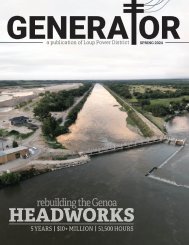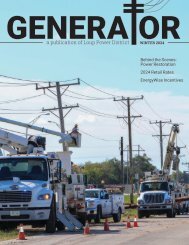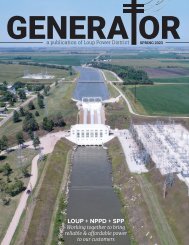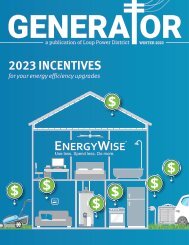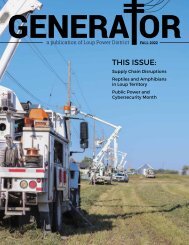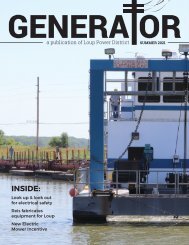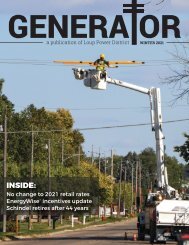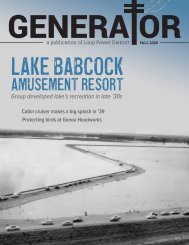Generator — Summer 2023
Learn about the Columbus Public Power Building and a building restoration project in Creston.
Learn about the Columbus Public Power Building and a building restoration project in Creston.
Create successful ePaper yourself
Turn your PDF publications into a flip-book with our unique Google optimized e-Paper software.
PUBLIC POWER EXPANSION<br />
In 1936, Loup created a Rural<br />
Electrification Division to provide<br />
service to an estimated 1,400 farms<br />
in Platte, Colfax, Nance, and Boone<br />
Counties. That same year, the Rural<br />
Electrification Administration (REA)<br />
announced that it would give $391,000<br />
to Loup for construction of 355 miles<br />
of electric lines to serve an estimated<br />
319 farms.<br />
Loup initially distributed the power<br />
it generated to both private and public<br />
power companies. By 1939, there were<br />
two other hydropower districts in the<br />
state <strong>—</strong> Platte Valley Public Power<br />
and Irrigation District and Central<br />
Nebraska (Tri-County) Public Power<br />
and Irrigation District.<br />
The districts were all generating<br />
power but needed to expand<br />
their markets. They had been<br />
contemplating the purchase of<br />
private power companies for some<br />
time for that purpose. Loup had<br />
debt obligations to the Public Works<br />
Administration, posing a funding<br />
problem.<br />
On Aug. 5, the same men who<br />
organized the Loup project helped<br />
create Consumers Public Power<br />
District to facilitate the purchase of<br />
those facilities. Loup River Public<br />
Power District’s President C.B. Fricke<br />
was named president of the debt-free<br />
Consumers.<br />
In October, Consumers assumed<br />
operation of the Columbus division<br />
of the Northwestern Public Service<br />
Company through a lease-purchase<br />
agreement. It purchased the company<br />
in July 1940 with $1.2 million in bonds.<br />
It was the first acquisition of a private<br />
utility by a public power district<br />
through bond issue.<br />
The hydro facilities continued to<br />
sell power to private companies. But<br />
that would soon change. By the end<br />
of 1943, Consumers Public Power<br />
District acquired all generation and<br />
distribution facilities across the state<br />
except for Nebraska Power Company<br />
in Omaha. The cost was more than<br />
$40 million paid for by revenue<br />
bonds. This change to public power<br />
caused much controversy throughout<br />
the state with some comparing it to<br />
socialism and communism.<br />
A PUBLIC POWER SYSTEM<br />
In 1940, the three hydro districts<br />
that formed Consumers <strong>—</strong> Loup,<br />
Platte Valley, and Tri-County <strong>—</strong><br />
signed an agreement to pool their<br />
generation and revenue. This<br />
would provide stability, prevent<br />
competition and allow them to finance<br />
growth. The agreement created<br />
the Nebraska Public Power System<br />
(NPPS), a wholesale marketing and<br />
transmission agency. Its threemember<br />
board consisted of the three<br />
district managers.<br />
The three unified districts also<br />
refinanced nearly $38 million in debt.<br />
The new bonds reduced both the<br />
interest and bond payments to give<br />
the districts an opportunity to pay off<br />
obligations while building revenues.<br />
Consumers leased its generating<br />
facilities to NPPS which began<br />
coordinating power generation and<br />
transmission. Rural public power<br />
districts continued to form across the<br />
state and purchased power from NPPS.<br />
(Central withdrew from NPPS in<br />
1949 to focus on irrigation.)<br />
A NEW BUILDING<br />
By 1940, Columbus was home to<br />
four public power entities <strong>—</strong> Loup<br />
River Public Power District, Loup’s<br />
Rural Electrification Division,<br />
Consumers Public Power District, and<br />
NPPS.<br />
Management and administrative<br />
offices for the four were scattered<br />
in rented facilities, mostly along<br />
13th Street in downtown Columbus.<br />
It was time to build a facility to<br />
accommodate all four. Board members<br />
of Consumers and Loup wanted a<br />
prime location at the northeast corner<br />
of 14th Street and 25th Avenue. Grace<br />
Episcopal Church and rectory was<br />
located there, but sold their property<br />
and relocated.<br />
The new “Public Power Building”<br />
opened formally to the public in May<br />
1941.<br />
In 1970, Nebraska Public Power<br />
District (NPPD) was formed following<br />
the merger of Consumers, Platte<br />
Valley Public Power and Irrigation<br />
District. and NPPS.<br />
Four years later, Loup moved into<br />
its new office at 2404 15th Street. In<br />
1976, NPPD transferred the title of<br />
the Public Power Building to the City<br />
of Columbus and moved into its new<br />
headquarters at 1414 15th Street in<br />
Columbus.<br />
SUMMER <strong>2023</strong> | 11



